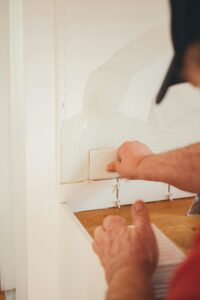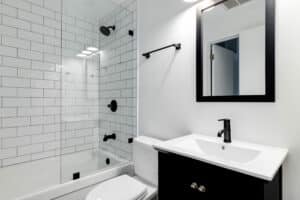Understanding Bathroom Renovations
Embarking on a bathroom renovation project can be a daunting task. However, with proper understanding and planning, one can achieve a desirable outcome while adhering to a budget. This section aims to provide insights into the crucial aspects of planning for bathroom renovations and common challenges encountered during the process.
The Importance of Planning
Planning is a pivotal aspect of any renovation project, especially for cost-effective bathroom renovations. A structured plan can help streamline the renovation process, ensuring that all elements are aligned with the budget and timeline. Proper planning involves researching, prioritizing requirements, forecasted budgeting, and having a clear vision of the desired end result. Notably, understanding the scope of the project, labor costs, material costs, and potential unforeseen expenses are integral parts of the planning phase.
When planning, it’s advisable to consider factors such as the size and layout of the bathroom, the need for structural changes, fixture replacements, and aesthetic enhancements. One should also consider the functionality and utility of the space, especially for commercial bathroom renovation projects.
For more detailed guidance on the planning process, refer to our article on bathroom renovations: a step-by-step guide for homeowners.
Common Challenges in Bathroom Renovations
While bathroom renovations can transform a space, they often come with a set of challenges. Common issues include unexpected plumbing problems, water damage, outdated electrical systems, and structural issues. These problems can cause delays and increase the overall cost of the project, highlighting the importance of a well-thought-out and realistic budget.
Furthermore, achieving a balance between aesthetics, functionality, and cost-effectiveness can also pose a challenge. For instance, choosing materials that are durable, easy to maintain, and reasonably priced requires careful consideration. Our article on choosing the right materials for your bathroom renovation offers valuable insights on this topic.
Lastly, unexpected issues may arise during the renovation process, such as complications related to removing old fixtures or dealing with hidden issues behind walls and floors. To avoid common pitfalls, be sure to check out our article on expert advice: common bathroom renovation mistakes to avoid.
Understanding these challenges can help individuals prepare better for their bathroom renovation projects, enabling them to effectively manage their expectations, budget, and timeline.
Budgeting for Bathroom Renovations
Budgeting is a critical part of any renovation project, especially when it comes to bathrooms. Having a clear understanding of the costs involved and how to plan your budget can pave the way for a smooth, hassle-free renovation process.
Key Factors Influencing Cost
Several factors can influence the cost of bathroom renovations. Some of the major components include:
- Size of the Bathroom: The larger the bathroom, the higher the cost of renovation. This is due to the increased amount of materials needed and potentially more labor hours.
- Quality of Materials: High-quality materials typically come with a higher price tag. However, investing in durable materials can save money in the long run by reducing the need for repairs or replacements. Read our guide on choosing the right materials for your bathroom renovation to learn more.
- Labor Costs: The cost of labor can vary depending on the complexity of the project and the professionals you hire.
- Plumbing and Electrical Work: Any changes to the existing plumbing or electrical setup can add to the cost.
- Additions and Upgrades: Adding new features or upgrading existing ones, like installing a new tub or adding heated floors, will also increase the cost.
| Factors | Potential Cost Range |
|---|---|
| Size of the Bathroom | $1,000 – $15,000 |
| Quality of Materials | $500 – $10,000 |
| Labor Costs | $500 – $5,000 |
| Plumbing and Electrical Work | $1,000 – $10,000 |
| Additions and Upgrades | $500 – $10,000 |
How to Develop a Realistic Budget
Developing a realistic budget for your bathroom renovation involves careful planning and consideration. Here are a few steps to guide you:
- Evaluate Your Finances: Determine how much you can afford to spend on the renovation without straining your finances.
- Identify Your Needs and Wants: Make a list of what you need to change and what you would like to change in your bathroom. Prioritize your needs over your wants.
- Get Estimates: Reach out to professionals for quotes or use online tools for an estimate. Remember to account for unexpected costs by setting aside an additional 10-20% of your budget.
- Consider the ROI: If you plan on selling your property in the future, consider the potential return on investment (ROI) of your renovation. Some upgrades can significantly increase the value of your property.
- Monitor Spending: Once you start the renovation, keep track of all expenses to ensure you stay within your budget.
Remember, cost-effective bathroom renovations don’t mean compromising on quality. With careful planning, it’s possible to create a beautiful and functional bathroom that fits your budget. For more expert tips and tricks, explore our comprehensive guide on bathroom renovations.
Cost-Effective Tips and Tricks
Executing cost-effective bathroom renovations requires a clear understanding of the potential savings strategies. These can range from thoughtful repurposing and recycling of materials to the careful consideration of DIY approaches versus hiring professionals.
The Value of Repurposing and Recycling
One of the most budget-friendly practices in bathroom renovations is to repurpose or recycle existing materials. Instead of purchasing new fixtures or tiles, a homeowner can breathe new life into existing items with a bit of creativity and effort.
For example, a fresh coat of paint or re-grouting can make old tiles look new again. Similarly, refinishing a bathtub or a vanity can drastically change the look of the bathroom at a fraction of the cost of replacement.
Another approach is to source second-hand materials. Often, high-quality items can be found at reduced prices from salvage yards, online marketplaces, or even from friends and neighbors who are also renovating.
Incorporating repurposed and recycled items not only saves money but also adds a unique, personal touch to the renovation. For more information on selecting the right materials, read our article on choosing the right materials for your bathroom renovation.
The Impact of DIY vs. Hiring Professionals
The decision to tackle a renovation project on your own versus hiring professionals can significantly impact the budget. DIY projects can save on labor costs, but they also require time, skill, and the right tools.
Basic jobs like painting, installing accessories, or even replacing faucets might be manageable for the average homeowner. More complex tasks, such as plumbing or electrical work, may require professional intervention to ensure safety and compliance with local building codes.
Remember, mistakes made during DIY can end up costing more in the long run if professionals need to be called in to correct them. Therefore, it’s important to realistically assess one’s abilities and time availability before opting for DIY.
If you’re considering a DIY approach, our article mastering diy: essential skills for bathroom renovation projects provides more insights.
In the end, the most cost-effective bathroom renovations balance budget planning, creative repurposing, and a strategic mix of DIY and professional work. By understanding these factors, homeowners can create a renovated space that meets their needs without breaking the bank.
Areas of Focus in Bathroom Renovations
When planning cost-effective bathroom renovations, it’s crucial to focus on three main areas: plumbing and fixtures, tiles and flooring, and lighting and ventilation. These components play a significant role in the functionality and aesthetics of your bathroom, and smart choices can lead to significant savings.
Plumbing and Fixtures
The first area of focus should be the plumbing and fixtures. Upgrading or repairing existing plumbing can prevent future issues, saving money in the long run. It’s also a good idea to consider water-efficient fixtures like low-flow toilets and showerheads, which can reduce water usage and lower utility bills.
When choosing fixtures, don’t equate cost with quality. Many reasonably priced fixtures are durable and stylish. For budget-friendly options, consider repurposing items or shopping at discount or second-hand stores.
For more tips and tricks on choosing the right fixtures for your bathroom renovation, visit our guide on choosing the right materials for your bathroom renovation.
Tiles and Flooring
Next, consider your tiles and flooring. Tile costs can add up, especially if you’re planning to tile large areas or use high-end tiles. To save money, consider using more affordable tiles or limiting the use of pricier tiles to certain areas or accent pieces.
As for flooring, options like vinyl or laminate can mimic the look of more expensive materials at a fraction of the cost. These materials are also durable and water-resistant, making them a practical choice for bathrooms.
Before making a decision, weigh the pros and cons of each material. Check out our article on choosing the right materials for your bathroom renovation for more information.
Lighting and Ventilation
Lastly, don’t overlook the importance of lighting and ventilation. Good lighting can enhance the aesthetics of your bathroom and improve functionality. LEDs, for instance, are energy-efficient and long-lasting, making them a cost-effective choice.
Ventilation is crucial for preventing mold and mildew, which can lead to costly repairs. An exhaust fan is a worthy investment, but there are also budget-friendly options like vented windows or passive vents.
Making informed decisions in these key areas can greatly contribute to successful and cost-effective bathroom renovations. For more insights into bathroom renovations, check out bathroom renovations: a step-by-step guide for homeowners.
Saving on Bathroom Fixtures
When planning cost-effective bathroom renovations, fixtures like toilets, showers, tubs, sinks, and vanities can significantly impact the project’s total cost. However, with smart strategies and careful planning, homeowners can save on these essential elements without compromising on quality and function.
Cost-Saving Strategies for Toilets
Toilets may seem like a straightforward fixture, but there are numerous options in the market, each with varying price points. Opting for a standard two-piece toilet with fewer advanced features can be a cost-effective choice. However, it’s important to consider long-term savings too. Water-saving toilets, while slightly more expensive upfront, can lead to substantial savings on water bills over time.
When replacing a toilet, one way to save costs is to retain the existing toilet’s footprint, as moving the plumbing can add to the renovation cost.
Cost-Saving Strategies for Showers and Tubs
When it comes to showers and tubs, cost savings can be achieved by choosing more affordable materials and designs. For instance, a prefabricated shower unit is usually less expensive than a custom tiled shower. Also, retaining the existing layout of the shower or tub area can minimize plumbing changes, thus reducing labor costs.
When considering tubs, a standard alcove tub could be a cost-effective option compared to freestanding or clawfoot tubs.
Cost-Saving Strategies for Sinks and Vanities
For sinks and vanities, one cost-saving strategy is to refurbish existing units rather than replacing them. A fresh coat of paint or new hardware can give a dated vanity a modern look.
Choosing a drop-in sink over an undermount model can also save costs, as the former is typically less expensive and easier to install. However, factor in your countertop material as undermount sinks may be a better choice for some surfaces.
In conclusion, cost-effective bathroom renovations require thoughtful planning and smart choices. By focusing on the most impactful elements and making wise decisions, homeowners can achieve a beautiful, functional bathroom that adds value to their home without breaking the bank. For more tips on planning a bathroom renovation, visit our guide on bathroom renovations.
Maximizing Value in Bathroom Renovations
As you plan for your bathroom renovation, it’s essential to consider how to get the most value from your investment. A cost-effective renovation isn’t just about cutting costs; it’s also about investing wisely to ensure quality, durability, and a high return on investment (ROI).
The Power of Quality and Durability
When selecting materials for your bathroom renovation, it’s crucial to prioritize quality and durability. While it might be tempting to save money upfront by choosing cheaper materials, these options often lack the longevity of their higher-quality counterparts. For instance, choosing high-quality tiles and fixtures can withstand wear and tear better, require less maintenance, and offer a more appealing aesthetic over time. For more information on choosing the right materials, check out our guide on choosing the right materials for your bathroom renovation.
Return on Investment (ROI) Factors
Bathroom renovations can significantly increase the value of your property if done right. Some aspects that can affect the ROI include the quality of the fixtures, the aesthetic appeal, the functionality of the space, and the overall quality of the work done.
To maximize ROI, consider investing in high-impact areas like modern fixtures, updated lighting, and efficient plumbing systems. Also, remember to keep your renovation in line with the overall style and quality of your property to avoid overcapitalization. For more tips on how to get the highest ROI from your bathroom renovation, read our article on luxury on a budget: tips for an upscale bathroom renovation.
Keeping Future Plans in Mind
When planning your bathroom renovation, consider your future plans. If you intend to sell your property in the future, you might want to opt for a more neutral design that will appeal to a broader range of potential buyers. On the other hand, if you plan to stay in your property for many years, you might prefer to customize the space to suit your personal taste.
Furthermore, consider the potential need for accessibility features in your bathroom. Incorporating elements such as grab bars or walk-in tubs can make your bathroom more accessible for all ages, adding value to your property. For more tips on enhancing accessibility, check out our article on enhancing accessibility: bathroom renovation tips for all ages.
In summary, maximizing the value in bathroom renovations involves a balance between managing costs, investing in quality materials, considering ROI factors, and planning for the future. By keeping these considerations in mind, you can achieve a bathroom renovation that not only meets your immediate needs but also provides long-term value.




